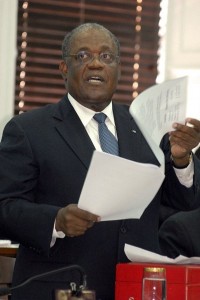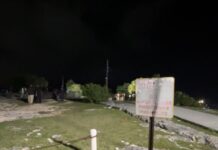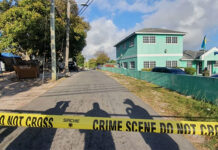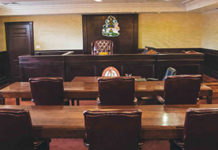
US Drone operation conducted over New Providence late last year…
Nassau, Bahamas – While members of the wutless media focus on what the chaotic FNM is doing across the country, Bahamas Press is monitoring a major decision by the Ingraham government to allow war type US drone planes to fly missions in the Bahamas.
According to the Los Angeles Times, the last mission flight over the Bahamas occurred on December 22 last year and confirmed that the mission sighted a Haitian sloop approaching the southern shoreline of New Providence.
According to the paper: “…a Guardian [drone name] trained its infrared eye on a sailboat heading toward the south shoreline of New Providence island in the Bahamas. Photographs of the sloop and grid coordinates were relayed by the U.S. embassy in Nassau. The Royal Bahamas Defense Forces found no drugs, but arrested 23 men, five women and a boy. The passengers were believed to be migrants from Haiti.”

What is interesting is the fact that it was Hubert Ingraham who, while on his feet in the House, protested the idea of the Bahamas controlling its airspace and agreed that it is something which should be managed by a foreign country.
It was also the former Prime Minister who agreed to allow any US vessel to board a vessel in the Bahamas without the presence of a Bahamian law officer onboard.
Bahamas Press wonders who gave the final approval for the drone flight over the country and we wonder whether or not any spy operations were carried out with the flights.
What is also amazing is the fact that none of the country’s citizenry was briefed about these developments nor has any member of the WUTLESS GUTLESS MEDIA alerted the Bahamians readers following the Los Angeles Times report. [http://www.latimes.com/news/nationworld/nation/la-na-drugs-caribbean-20120623,0,3135494.story ].
Bahamas Press is going to ask the Opposition whether they knew about these developments and, if they did, why they never informed the Bahamian people.
And while the US Homeland Security office is at it, we wonder if they could fly some of them drones over Lyford Cay and curb those suspicious activities out there?
WE REPORT YINNER DECIDE!
See Los Angeles Times report below:
U.S. plans more drone flights over Caribbean
The move is intended to fight drug smugglers who have been pushed to the ocean by greater border surveillance. But the unmanned aircraft have a limited record of success over the open water.
The move would dramatically increase U.S. drone flights in the Western Hemisphere, more than doubling the number of square miles now covered by the department’s fleet of nine surveillance drones, which are used primarily on the northern and southwestern U.S. borders.
But the high-tech aircraft have had limited success spotting drug runners in the open ocean. The drones have largely failed to impress veteran military, Coast Guard and Drug Enforcement Agency officers charged with finding and boarding speedboats, fishing vessels and makeshift submarines ferrying tons of cocaine and marijuana to America’s coasts.
“The question is: Will they be effective? We have no systematic evidence on how effective they are,” said Bruce Bagley, who studies U.S. counter-narcotics efforts at the University of Miami in Coral Gables, Fla.
Despite that, a new control station will arrive this month in Corpus Christi, Texas, allowing Predators based there to cover more of the Gulf of Mexico. An additional drone will be delivered this year to the U.S. Customs and Border Protection’s base in Cocoa Beach, Fla., for operations in the Caribbean.
The Federal Aviation Administration has already approved a flight path for the drones to fly more than 1,000 miles to the Mona Passage, the strait between Puerto Rico and the Dominican Republic.
“There is a lot more going on in the deep Caribbean, and we would like to know more,” said a law enforcement official familiar with the program who was not authorized to speak publicly. The official said drones may be based temporarily at airfields in the Dominican Republic and Puerto Rico.
The Predator B is best known as the drone used by the CIA to find and kill Al Qaeda terrorists in Pakistan and Yemen. An unarmed version patrols the U.S. borders searching known overland smuggling routes.
On the ocean, however, there are no rutted trails or roads to follow. And the Predator cannot cover as much open water as larger, higher-flying surveillance aircraft, such as the Global Hawk.
“I’m not sure just because it’s a UAV [unmanned aerial vehicle] that it will solve and fit in our problem set,” the top military officer for the region, Air Force Gen. Douglas M. Fraser, said recently.
Fraser’s command contributes ships and manned surveillance airplanes to the Joint Interagency Task Force South. Last year, the task force worked with U.S. agencies and other countries to seize 119 metric tons of cocaine, valued at $2.35 billion.
For the recent counter-narcotics flights over the Bahamas, border agents deployed a maritime variant of the Predator B called a Guardian with a SeaVue radar system that can scan large sections of open ocean. Drug agents can check a ship’s unique radio pulse in databases to identify the boat and owner.
The planned drone flights are partly a response to demands from leaders in the western Caribbean to shift more drug agents, surveillance aircraft and ships into the area, as cartels have switched from the closely watched U.S.-Mexico border to seaborne routes. In the last four years, drug seizures in the Caribbean and the Gulf of Mexico have increased 36%, according to the Department of Homeland Security.
“As we tighten the land borders, it squishes out to the seas,” said the law enforcement official.
Over the last several years, however, drug-war personnel have been diverted from the Caribbean to the southwestern U.S. border. In Puerto Rico, for example, 1 out of 8 DEA positions is vacant.
The increase in drug traffic has contributed to an unprecedented rise in homicides in Puerto Rico, a major transit point for cocaine moving from Central America to northeastern U.S. cities. In 2011, the homicide rate hit a historic high of 1,136, with 8 out of 10 killings related to drug trafficking.
“We need help fighting this battle along the Caribbean border to protect U.S. citizens there being buffeted by violence,” Puerto Rico’s Gov. Luis Fortuno told a congressional panel this week.
Despite budget cuts in other areas, Customs and Border Protection has requested $5.8 million to push its drone operations farther into the Caribbean and the Gulf of Mexico.
But test flights for the Guardian showed disappointing results in the Bahamas, according to two law enforcement officials familiar with the program who were not authorized to speak publicly.
During more than 1,260 hours in the air off the southeastern coast of Florida, the Guardian assisted in only a handful of large-scale busts, the officials said.
One of the most recent occurred early Dec. 22, when a Guardian trained its infrared eye on a sailboat heading toward the south shoreline of New Providence island in the Bahamas. Photographs of the sloop and grid coordinates were relayed by the U.S. embassy in Nassau. The Royal Bahamas Defense Forces found no drugs, but arrested 23 men, five women and a boy. The passengers were believed to be migrants from Haiti.
The head of an interagency drug task force based in the Bahamas called the mission a “great case” in an internal email obtained by The Times. The mission proved “what we all suspect to be the case with a piece of equipment that has such promising capabilities and potential,” wroteU.S. Coast GuardCmdr. Louie C. Parks Jr.
But federal officials who received the laudatory message said it only underscored that such success stories have been extremely rare.







